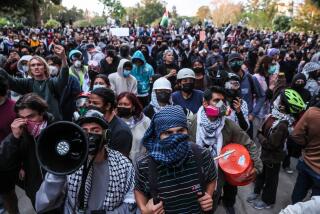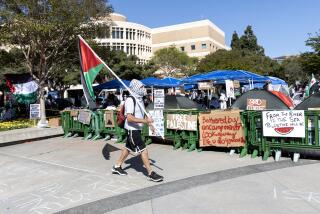793 Jailed, Explosives Seized on Peru Campuses
- Share via
LIMA, Peru — Police raided five university campuses in Lima early Friday, arrested 793 people suspected of having terrorist links and seized 650 pounds of explosives, Interior Minister Abel Salinas said.
He said police encountered resistance at the University of San Marcos, where three police officers were wounded in a shoot-out. Salinas said one suspect was wounded there and died later.
A senior anti-insurgency police officer said that most of those detained were students and professors, but some had no direct connection with the universities.
Jorge Campos Rey, rector of San Marcos, said the raids violated the centuries-old Latin American tradition of keeping university campuses off-limits to police.
‘Taken by Surprise’
“They used gun butts to break doors, windows, filing cabinets, and they carried off documents,” he told reporters Friday at the university, Peru’s largest with an enrollment of 45,000. “The students were taken by surprise as they slept.”
Beginning soon after Lima’s 1 a.m. curfew, police moved onto the campuses of San Marcos and two of its branches and of Enrique Guzman Teachers College and the University of Engineering. They stayed until after 5 a.m.
Authorities said they found 650 pounds of dynamite, fuses and detonators for making bombs, guns and knives in a search of dormitories and classrooms.
Military and police intelligence officials describe many Lima universities, particularly San Marcos, as being havens for students who are active in leftist guerrilla groups and use campuses as staging grounds for terrorist attacks.
Reason for Raids
The official news agency Andina said the raids were intended “to verify the existence of terrorist centers responsible for recent attacks in the capital.”
Gen. Jorge Flores Torres, war minister in President Alan Garcia’s Cabinet, said, “We are aware that in those centers of learning there has been terrorist proselytizing.”
Officials said the raids were legal under a state of emergency imposed here a year ago to help security forces combat guerrillas.
Garcia called the raids “a necessary measure in the struggle against terrorism.”
He said the government would not interfere with academic freedom, but “we must investigate until the final consequences all those who may have something to do with this painful subject of terrorism.”
Photographer’s Report
Police closed the campuses to the public, but an Associated Press photographer who gained entry to the main San Marcos campus said that dormitories and administrative buildings appeared to have been ransacked.
A statue of the late Argentine revolutionary Ernesto (Che) Guevara was smashed, but students had replaced it on its pedestal, minus an arm and part of a leg.
Posters praising Lenin, Mao and Marx were pasted above the entrance to the university’ s administrative offices.
Revolutionary slogans written on buildings denounced the government and praised Fidel Castro’s Cuban revolution and Sendero Luminoso (Shining Path), a Maoist guerrilla group that has been increasingly active in Peru since 1980.
Extremist Elements
San Marcos University is one of the two oldest universities in Latin America. Critics assert that in recent years it has fallen under control of extremist elements among student body and faculty.
Garcia charged last week that Shining Path guerrillas and “other subversives” used university classrooms to lecture students on their movement.
Hundreds of students gathered at midday Friday and tried to march in protest to Lima’s downtown San Martin Plaza, but riot police broke up the march and arrested stragglers.
A statement distributed by students accused Garcia’s government of “fascist” policies and said it had gone “as far as destroying the statue of the glorious Che (Guevara) in the mistaken belief that in this way revolutionary ideas are destroyed.”
More to Read
Sign up for Essential California
The most important California stories and recommendations in your inbox every morning.
You may occasionally receive promotional content from the Los Angeles Times.










